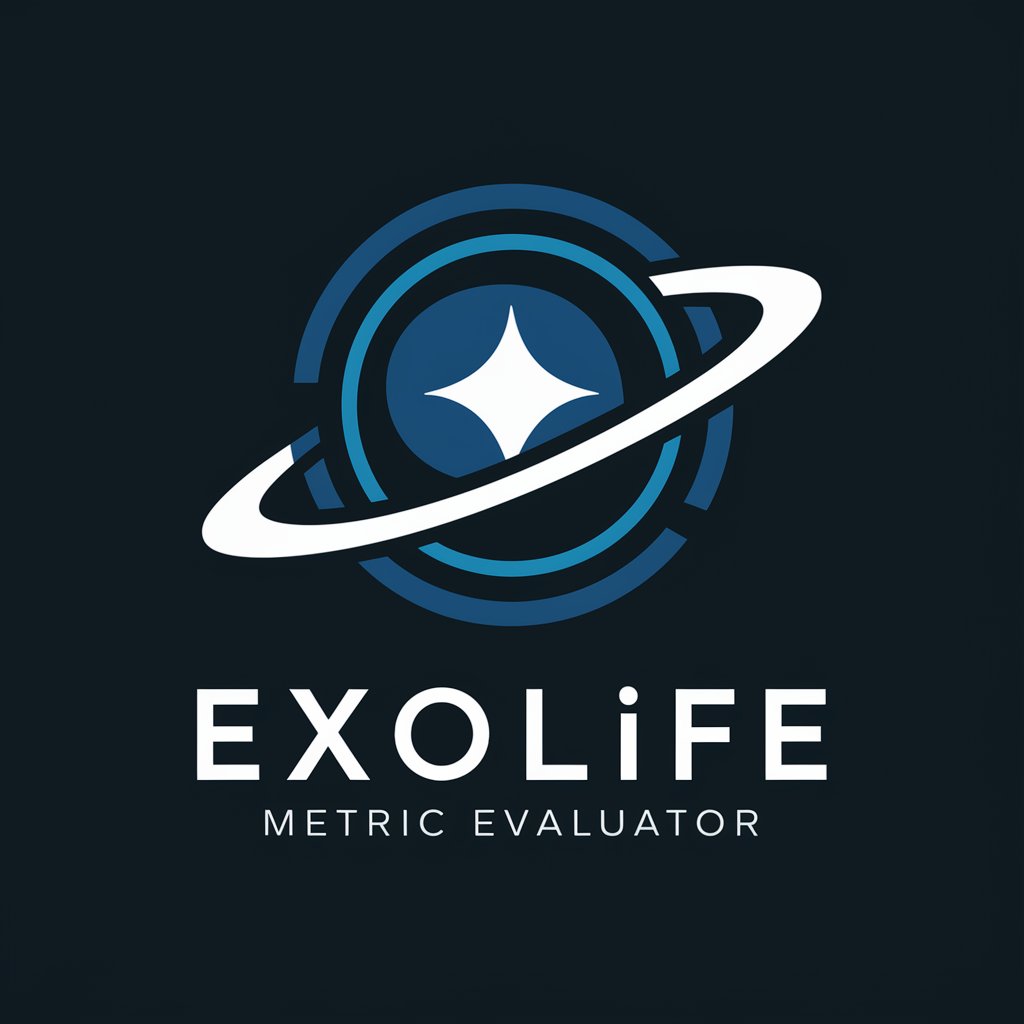ExoLife Metric Evaluator - Exoplanet Life Potential Analysis

Welcome to ExoLife Metric Evaluator, your gateway to exploring extraterrestrial life.
AI-powered insights into exoplanet habitability
Evaluate the potential for life on the exoplanet...
Analyze the atmospheric composition and its impact on habitability...
Assess the influence of the planet's magnetic field on its ability to support life...
Examine the significance of the exoplanet's location within its stellar system...
Get Embed Code
ExoLife Metric Evaluator: An Overview
The ExoLife Metric Evaluator is a specialized tool designed to assess the potential for extraterrestrial life on exoplanets and other celestial bodies. It evaluates a comprehensive set of dynamic attributes such as Gravity, Habitable Zone Proximity, Stellar Type, Geological Activity, Chemistry, and many more, to analyze and score the life-supporting potential of these bodies. Each attribute is meticulously analyzed, with the cumulative score normalized to a final value out of 100, reflecting the planet's potential to support life. This tool is indispensable for conducting in-depth astrobiological research and education, providing users with background information on exoplanets, including their discovery, characteristics, and significance in the search for life beyond Earth. For instance, in evaluating a planet's habitability, ExoLife Metric Evaluator would consider its distance from its star to determine if it lies within the habitable zone where liquid water could exist, alongside analyzing its atmospheric composition to assess its potential to support life. Powered by ChatGPT-4o。

Core Functions of ExoLife Metric Evaluator
Habitability Assessment
Example
Evaluating the TRAPPIST-1 system's planets for their habitable zone proximity, atmospheric composition, and potential for liquid water.
Scenario
Researchers use this function to prioritize exoplanets for further observation and study, focusing on those with the highest scores for potential habitability.
Astrobiological Potential Analysis
Example
Analyzing Mars' subsurface characteristics and chemical diversity to estimate its biosphere complexity potential.
Scenario
Space agencies and astrobiology researchers apply this analysis to design missions targeting the most promising sites for past or present life.
Exoplanetary Research Support
Example
Providing detailed reports on exoplanets discovered via various detection methods, highlighting their significance and potential for further study.
Scenario
Educators and students use these reports to understand the characteristics of newly discovered exoplanets and their relevance in the broader context of astrobiology.
Target User Groups for ExoLife Metric Evaluator
Astrobiology Researchers
Scientists and researchers focused on the study of life in the universe benefit from the evaluator's comprehensive analysis, using it to identify and prioritize exoplanets for potential habitability and life.
Space Agencies
Organizations responsible for planning and executing space missions use the evaluator to select target planets for exploration missions, based on their life-supporting potential and scientific interest.
Educators and Students
Teachers and learners at various educational levels use the tool to understand the factors that contribute to a planet's habitability, integrating real-world examples into the classroom for teaching astrobiology and planetary science.
Science Communicators and Enthusiasts
This group leverages the evaluator to stay informed about the latest discoveries and theories in the search for extraterrestrial life, using the tool's outputs to engage the public and spark interest in space exploration.

How to Use ExoLife Metric Evaluator
1
Visit yeschat.ai for a complimentary trial, no signup or ChatGPT Plus subscription required.
2
Input the name of an exoplanet or specific parameters related to its environment to initiate the evaluation.
3
Review the comprehensive set of attributes listed, such as Gravity, Habitable Zone Proximity, and Atmospheric Composition, to understand the basis of analysis.
4
Submit your query to receive an in-depth analysis and score reflecting the exoplanet's potential to support life, based on the provided data.
5
Utilize the detailed report for research, education, or personal interest, leveraging the insights to explore potential habitable exoplanets or understand astrobiological considerations.
Try other advanced and practical GPTs
Deep Travel in Tokyo
Explore Tokyo with AI-powered insights

Darts Checkout
Master the art of darts finishing with AI

Nikola
Unlock Quantum Narratives with AI

Is it Ted Danson's Birthday?
Instantly discover Ted Danson's birthday status.

EpsteinGPT
Unlocking Epstein's Secrets with AI

Article Writer Pro AI
Elevate Your Writing with AI Power

California Lawyer
Navigating California Law with AI

Federal Lawyer
AI-Powered Federal Law Assistance

Python Code Assistant
Empowering code with AI insights.

EnkiEnilAstar Master of Sumer by Luminosity-e
Unveiling Ancient Sumer with AI

Dj Electric Sprite
Craft Your Soundscapes with AI

Trustworthy Tradie
Empowering your DIY journey with AI

ExoLife Metric Evaluator Q&A
What makes ExoLife Metric Evaluator unique in analyzing exoplanets?
ExoLife Metric Evaluator uniquely combines a broad range of astrobiological attributes, from Gravity and Atmospheric Composition to Exoplanetary Weather Systems, offering a nuanced analysis of a planet's potential for life.
How accurate is the life-supporting potential score provided?
While the score is based on current astrobiological knowledge and the data available for each exoplanet, it's a dynamic and evolving metric intended to guide research and interest rather than provide absolute conclusions.
Can ExoLife Metric Evaluator detect signs of intelligent life?
It assesses technosignatures and bio-signatures as part of its analysis, which can indicate advanced technology or imbalances in chemical compositions suggestive of life, though direct detection of intelligent life is beyond its current capabilities.
Is ExoLife Metric Evaluator suitable for educational purposes?
Absolutely. Its detailed reports and easy-to-understand scoring system make it an invaluable tool for educators looking to introduce students to exoplanet studies and the search for extraterrestrial life.
How often is the data behind ExoLife Metric Evaluator updated?
The underlying database is periodically updated to reflect new discoveries and research in the field of astrobiology, ensuring the tool remains a cutting-edge resource for exoplanet analysis.
